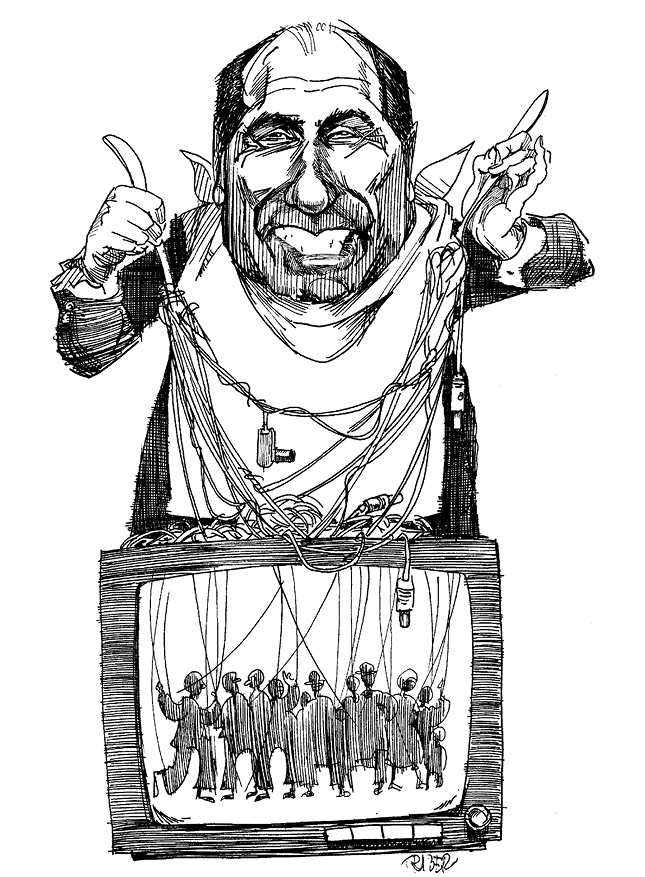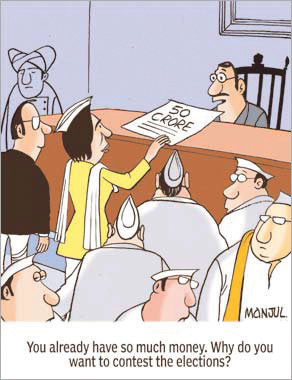Table of Contents
6
Political Parties
Overview
 In this tour of democracy, we have come across political parties several times. In Class IX, we noticed the role of political parties in the rise of democracies, in the formation of constitutional designs, in electoral politics and in the making and working of governments. In this textbook, we have glanced at political parties as vehicles of federal sharing of political power and as negotiators of social divisions in the arena of democratic politics. Before concluding this tour, let us take a close look at the nature and working of political parties, especially in our country. We begin by asking two common questions: Why do we need parties? How many parties are good for a democracy? In the light of these, we introduce the national and regional political parties in today’s India and then look at what is wrong with political parties and what can be done about it.
In this tour of democracy, we have come across political parties several times. In Class IX, we noticed the role of political parties in the rise of democracies, in the formation of constitutional designs, in electoral politics and in the making and working of governments. In this textbook, we have glanced at political parties as vehicles of federal sharing of political power and as negotiators of social divisions in the arena of democratic politics. Before concluding this tour, let us take a close look at the nature and working of political parties, especially in our country. We begin by asking two common questions: Why do we need parties? How many parties are good for a democracy? In the light of these, we introduce the national and regional political parties in today’s India and then look at what is wrong with political parties and what can be done about it.
Why do we need political parties?
Political parties are easily one of the most visible institutions in a democracy. For most ordinary citizens, democracy is equal to political parties. If you travel to remote parts of our country and speak to the less educated citizens, you could come across people who may not know anything about our Constitution or about the nature of our government. But chances are that they would know something about our political parties. At the same time this visibility does not mean popularity. Most people tend to be very critical of political parties. They tend to blame parties for all that is wrong with our democracy and our political life. Parties have become identified with social and political divisions.
Therefore, it is natural to ask – do we need political parties at all? About hundred years ago there were few countries of the world that had any political party. Now there are few that do not have parties. Why did political parties become so omnipresent in democracies all over the world? Let us first answer what political parties are and what they do, before we say why we need them.
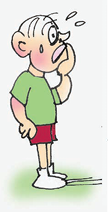
So, you agree with me. Parties are partial, partisan and lead to partitions. Parties do nothing but divide people. That is their real function!
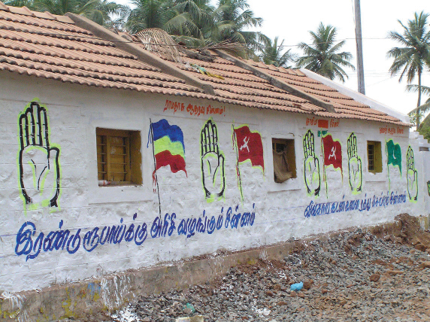
(1)
© (1) M Govarthan (2) A Muralidharan (3) M Moorthy (4) T Singaravelou, The Hindu
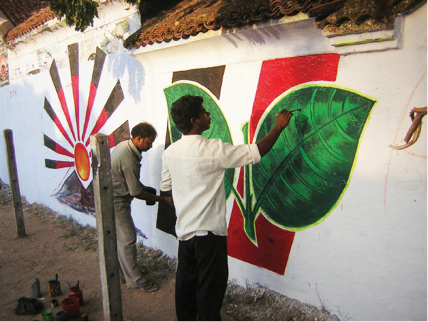
(2)
Election Commission has officially banned wall writing by parties during election times. Most political parties argue that was the cheapest way for their campaign. These election times used to create amazing graffiti on the walls. Here are some examples from Tamil Nadu.
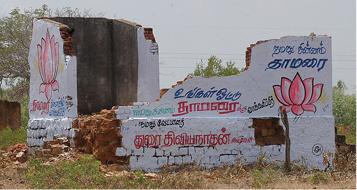
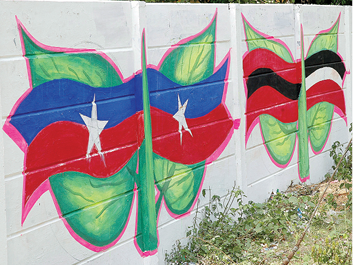
Meaning
A political party is a group of people who come together to contest elections and hold power in the government. They agree on some policies and programmes for the society with a view to promote the collective good. Since there can be different views on what is good for all, parties try to persuade people why their policies are better than others. They seek to implement these policies by winning popular support through elections.

Thus, parties reflect fundamental political divisions in a society. Parties are about a part of the society and thus involve partisanship. Thus a party is known by which part it stands for, which policies it supports and whose interests it upholds. A political party has three components:
the leaders,
the active members and
the followers
Functions
What does a political party do? Basically, political parties fill political offices and exercise political power. Parties do so by performing a series of functions:
1. Parties contest elections. In most democracies, elections are fought mainly among the candidates put up by political parties. Parties select their candidates in different ways. In some countries, such as the USA, members and supporters of a party choose its candidates. Now more and more countries are following this method. In other countries like India, top party leaders choose candidates for contesting elections.
 Partisan: A person who is strongly committed to a party, group or faction. Partisanship is marked by a tendency to take a side and inability to take a balanced view on an issue.
Partisan: A person who is strongly committed to a party, group or faction. Partisanship is marked by a tendency to take a side and inability to take a balanced view on an issue.
2. Parties put forward different policies and programmes and the voters choose from them. Each of us may have different opinions and views on what policies are suitable for the society. But no government can handle such a large variety of views. In a democracy, a large number of similar opinions have to be grouped together to provide a direction in which policies can be formulated by the governments. This is what the parties do. A party reduces a vast multitude of opinions into a few basic positions which it supports. A government is expected to base its policies on the line taken by the ruling party.
3 Parties play a decisive role in making laws for a country. Formally, laws are debated and passed in the legislature. But since most of the members belong to a party, they go by the direction of the party leadership, irrespective of their personal opinions.
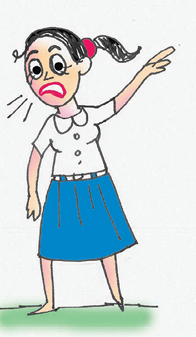
Okay, granted that we can’t live without political parties. But tell me on what grounds do people support a political party?
4. Parties form and run governments. As we noted last year, the big policy decisions are taken by political executive that comes from the political parties. Parties recruit leaders, train them and then make them ministers to run the government in the way they want.
5. Those parties that lose in the elections play the role of opposition to the parties in power, by voicing different views and criticising government for its failures or wrong policies. Opposition parties also mobilise opposition to the government.
6. Parties shape public opinion. They raise and highlight issues. Parties have lakhs of members and activists spread all over the country. Many of the pressure groups are the extensions of political parties among different sections of society. Parties sometimes also launch movements for the resolution of problems faced by people. Often opinions in the society crystallise on the lines parties take.
Ruling Party: Political party that runs government.
7.Parties provide people access to government machinery and welfare schemes implemented by governments. For an ordinary citizen it is easy to approach a local party leader than a government officer. That is why, they feel close to parties even when they do not fully trust them. Parties have to be responsive to people’s needs and demands. Otherwise people can reject those parties in the next elections.
Necessity
This list of functions in a sense answers the question asked above: we need political parties because they perform all these functions. But we still need to ask why modern democracies cannot exist without political parties. We can understand the necessity of political parties by imagining a situation without parties. Every candidate in the elections will be independent. So no one will be able to make any promises to the people about any major policy changes. The government may be formed, but its utility will remain ever uncertain. Elected representatives will be accountable to their constituency for what they do in the locality. But no one will be responsible for how the country will be run.
We can also think about it by looking at the non-party based elections to the panchayat in many states. Although, the parties do not contest formally, it is generally noticed that the village gets split into more than one faction, each of which puts up a ‘panel’ of its candidates. This is exactly what the party does. That is the reason we find political parties in almost all countries of the world, whether these countries are big or small, old or new, developed or developing.
The rise of political parties is directly linked to the emergence of representative democracies. As we have seen, large societies need representative democracy. As societies became large and complex, they also needed some agency to gather different views on various issues and to present these to the government. They needed some ways, to bring various representatives together so that a responsible government could be formed. They needed a mechanism to support or restrain the government, make policies, justify or oppose them. Political parties fulfill these needs that every representative government has. We can say that parties are a necessary condition for a democracy.

 Categorise these photographs by the functions of political parties they illustrate. Find one photograph or news clipping from your own area for each of the functions listed above.
Categorise these photographs by the functions of political parties they illustrate. Find one photograph or news clipping from your own area for each of the functions listed above.  (1)
(1)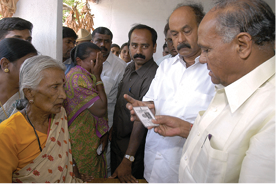 (2)
(2)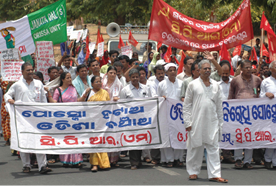 (3)
(3)© (1) C V Subrahmanyan (2) K Gopinathan
(3) A Chakrabarty, The Hindu
1: Activists of BJP Mahila Morcha demonstrate against hike in prices of onions and LPG in Visakhapatnam.
2: Minister distributes Rs One lakh cheque to the families of hooch victims at their houses.
3: Activists of CPI (M), CPI, OGP and JD (S) take out a rally in Bhubaneswar to protest against POSCO, the Korean steel company for being permitted by the State Government to export iron ore from Orissa to feed steel plants in China and Korea.

How many parties should we have?
In a democracy any group of citizens is free to form a political party. In this formal sense, there are a large number of political parties in each country. More than 750 parties are registered with the Election Commission of India. But not all these parties are serious contenders in the elections. Usually only a handful of parties are effectively in the race to win elections and form the government. So the question, then is: how many major or effective parties are good for a democracy?
In some countries, only one party is allowed to control and run the government. These are called one-party systems.
In Class IX, we noted that in China, only the Communist Party is allowed to rule. Although, legally speaking, people are free to form political parties, it does not happen because the electoral system does not permit free competition for power. We cannot consider one-party system as a good option because this is not a democratic option. Any democratic system must allow at least two parties to compete in elections and provide a fair chance for the competing parties to come to power.
In some countries, power usually changes between two main parties. Several other parties may exist, contest elections and win a few seats in the national legislatures. But only the two main parties have a serious chance of winning majority of seats to form government. Such a party system is called two-party system. The United States of America and the United Kingdom are examples of two-party system.
If several parties compete for power, and more than two parties have a reasonable chance of coming to power either on their own strength or in alliance with others, we call it a multiparty system. Thus in India, we have a multiparty system. In this system, the government is formed by various parties coming together in a coalition. When several parties in a multi-party system join hands for the purpose of contesting elections and winning power, it is called an alliance or a front. For example, in India there were three such major alliances in 2004 parliamentary elections– the National Democratic Alliance, the United Progressive Alliance and the Left Front. The multiparty system often appears very messy and leads to political instability. At the same time, this system allows a variety of interests and opinions to enjoy political representation.

I wonder how politicians manage these coalitions. I can’t even remember the names of all the parties.
So, which of these is better? Perhaps the best answer to this very common question is that this is not a very good question. Party system is not something any country can choose. It evolves over a long time, depending on the nature of society, its social and regional divisions, its history of politics and its system of elections. These cannot be changed very quickly. Each country develops a party system that is conditioned by its special circumstances. For example, if India has evolved a multiparty system, it is because the social and geographical diversity in such a large country is not easily absorbed by two or even three parties. No system is ideal for all countries and all situations.

A Moral force in politics?
The inspiration behind the following imaginary narrative is
Shri Kishen Patnaik (1930–2004), also known as Kishenji. He was elected as a Member of Parliament from Sambalpur, Odisha in 1962.
What did Kishenji mean by an alternative political formation? The question came up in a conversation between Sudha, Karuna, Shaheen and Gracy. All four women had led very powerful people’s movements in different parts of the country. They were meeting in a village in Odisha, away from their day-to-day struggles, to think afresh the future of people’s movements.
The discussion naturally turned to Kishenji, who was regarded as a friend, political philosopher and moral guide by all the movement groups in the country. He had argued that people’s movement should embrace politics openly. His argument was simple yet powerful. Movements focused on a single issue are suitable as long as we wish to achieve limited changes in a particular aspect of life. But if we wish to bring about a fundamental social transformation, or basic change even in one aspect of life, we would need a political organisation. People’s movement must establish a new political formation to act as a moral force in politics. This was an urgent task, he said, because all the existing political parties had become irrelevant for social transformation.
“But Kishenji never clarified what that organisation will be. He talked of an alternative political formation or a third force in politics. But did he mean a political party?” said Gracy. She felt that an old style political party was not the right instrument for social change.
Sudha agreed with her. “I have thought about it several times. I agree that all the struggles that we are involved with – the struggle against displacement, against globalisation, against caste and gender oppression and for an alternative kind of development – all this is political. But the moment we form a party, all the goodwill we have earned all these years will be lost. People will think of us as no different from other politicians.”
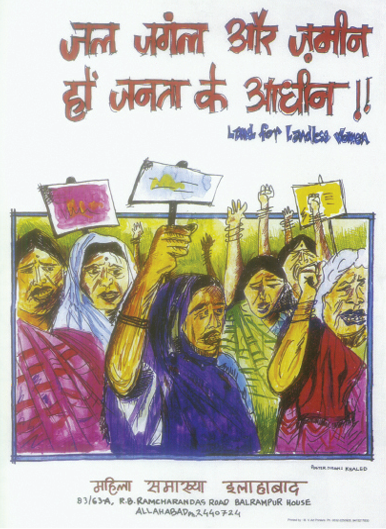
“Besides”, added Karuna, “we have seen that a lot can be achieved by putting pressure on the existing political parties. We tried putting up candidates in panchayat elections, but the results were not very encouraging. People respect our work, they even adore us, but when it comes to voting they go for the established political parties.”
Shaheen did not agree with them: “Let us be very clear. Kishenji wanted all the people’s movements to forge a new political party. Of course he wanted this party to be a different kind of a party. He was not for political alternatives, but for an alternative kind of politics.”
Kishenji is no more. What would be your advice to these four activists? Should they form a new political party? Can a political party become a moral force in politics? What should that party be like?


Let us apply what we have learnt about party systems to the various states within India. Here are three major types of party systems that exist at the State level. Can you find the names of at least two States for each of these types?
Two-party system
Multiparty system with two alliances
Multiparty system

Popular Participation in political parties
It is often said that political parties are facing a crisis because they are very unpopular and the citizens are indifferent to political parties. The available evidence shows that this belief is only partly true for India. The evidence, based on a series of large sample surveys conducted over several decades, shows that:
Political parties do not enjoy much trust among the people in South Asia. The proportion of those who say their trust in political parties is ‘not much’ or ‘not at all’ is more than those who have ‘some’ or ‘great’ trust.
The same is true of most other democracies as well. Political parties are one of the least trusted institutions all over the world.
Yet the level of participation in the activities of political parties was fairly high. The proportion of those who said they were members of some political party was higher in India than many advanced countries like Canada, Japan, Spain and South Korea.
Over the last three decades the proportion of those who report to be members of political parties in India has gone up steadily.
The proportion of those who say they feel ‘close to a political party’ has also gone up in India in this period.
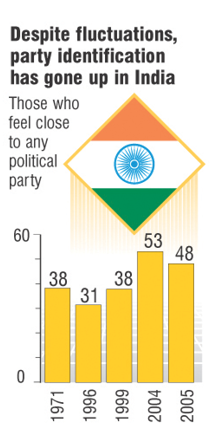
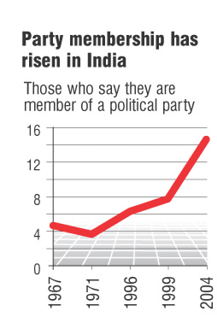
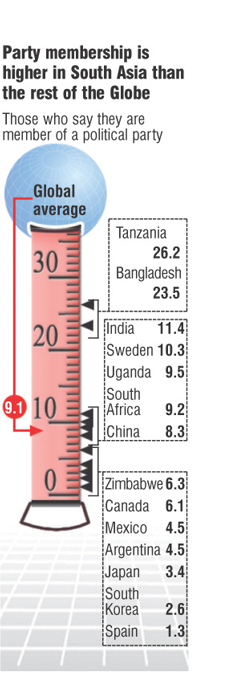
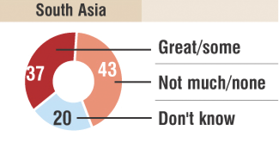
Source: SDSA Team, State of Democracy in South Asia, Delhi: Oxford University Press, 2007
© Tab - The Calgary Sun, Cagle Cartoons Inc![pg79.psd]()
Does the cartoon reflect the data graphics shown on the previous page?
National parties
Democracies that follow a federal system all over the world tend to have two kinds of political parties: parties that are present in only one of the federal units and parties that are present in several or all units of the federation. This is the case in India as well. There are some country-wide parties, which are called ‘national parties’. These parties have their units in various states. But by and large, all these units follow the same policies, programmes and strategy that is decided at the national level.
Every party in the country has to register with the Election Commission. While the Commission treats all parties equally, it offers some special facilities to large and established parties. These parties are given a unique symbol – only the official candidates of that party can use that election symbol. Parties that get this privilege and some other special facilities are ‘recognised’ by the Election Commission for this purpose. That is why these parties are called, ‘recognised political parties’. The Election Commission has laid down detailed criteria of the proportion of votes and seats that a party must get in order to be a recognised party. A party that secures at least six per cent of the total votes in an election to the Legislative Assembly of a State and wins at least two seats is recognised as a State party. A party that secures at least six per cent of the total votes in Lok Sabha elections or Assembly elections in four States and wins at least four seats in the Lok Sabha is recognised as a national party.
For more details
about registration and recognition of political parties by the Election Commission of India, visit https://eci.gov.in
According to this classification, there were seven recognised national parties in the country in 2018. Let us learn something about each of these parties.

All India Trinamool Congress (AITC): Launched on 1 January 1998 under the leadership of Mamata Banerjee. Recognised as a national party in 2016. The party’s symbol is flowers and grass. Committed to secularism and federalism. Has been in power in West Bengal since 2011. Also has a presence in Arunachal Pradesh, Manipur and Tripura. In the General Elections held in 2019, it got 4.07 per cent votes and won 22 seats, making it the fourth largest party in the Lok Sabha.
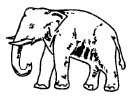
Bahujan Samaj Party (BSP): Formed in 1984 under the leadership of Kanshi Ram. Seeks to represent and secure power for the bahujan samaj which includes the dalits, adivasis, OBCs and religious minorities. Draws inspiration from the ideas and teachings of Sahu Maharaj, Mahatma Phule, Periyar Ramaswami Naicker and Babasaheb Ambedkar. Stands for the cause of securing the interests and welfare of the dalits and oppressed people. It has its main base in the state of Uttar Pradesh and substantial presence in neighbouring states like Madhya Pradesh, Chhattisgarh, Uttarakhand, Delhi and Punjab. Formed government in Uttar Pradesh several times by taking the support of different parties at different times. In the Lok Sabha elections held in 2019, it polled about 3.63 per cent votes and secured 10 seats in the Lok Sabha.

Bharatiya Janata Party (BJP): Founded in 1980 by reviving the erstwhile Bharatiya Jana Sangh, formed by Syama Prasad Mukherjee in 1951. Wants to build a strong and modern India by drawing inspiration from India’s ancient culture and values; and Deendayal Upadhyaya’s ideas of integral humanism and Antyodaya. Cultural nationalism (or ‘Hindutva’) is an important element in its conception of Indian nationhood and politics. Wants full territorial and political integration of Jammu and Kashmir with India, a uniform civil code for all people living in the country irrespective of religion, and ban on religious conversions. Its support base increased substantially in the 1990s. Earlier limited to north and west and to urban areas, the party expanded its support in the south, east, the north-east and to rural areas. Came to power in 1998 as the leader of the National Democratic Alliance (NDA) including several regional parties. Emerged as the largest party with 303 members in the 2019 Lok Sabha elections. Currently leads the ruling NDA government at the Centre.
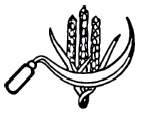
Communist Party of India (CPI): Formed in 1925. Believes in Marxism-Leninism, secularism and democracy. Opposed to the forces of secessionism and communalism. Accepts parliamentary democracy as a means of promoting the interests of the working class, farmers and the poor. Became weak after the split in the party in 1964 that led to the formation of the CPI(M). Significant presence in the states of Kerala, West Bengal, Punjab, Andhra Pradesh and Tamil Nadu. Its support base had gradually declined over the years. It secured less than 1 per cent votes and 2 seats in the 2019 Lok Sabha elections. Advocates the coming together of all left parties to build a strong left front.
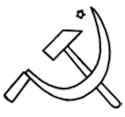
Communist Party of India - Marxist (CPI-M): Founded in 1964. Believes in Marxism-Leninism. Supports socialism, secularism and democracy and opposes imperialism and communalism. Accepts democratic elections as a useful and helpful means for securing the objective of socio-economic justice in India. Enjoys strong support in West Bengal, Kerala and Tripura, especially among the poor, factory workers, farmers, agricultural labourers and the intelligentsia. Critical of the new economic policies that allow free flow of foreign capital and goods into the country. Was in power in West Bengal without a break for 34 years. In the 2019 Lok Sabha elections, it won about 1.75 per cent of votes and 3 seats.
 Indian National Congress (INC): Popularly known as the Congress Party. One of the oldest parties of the world. Founded in 1885 and has experienced many splits. Played a dominant role in Indian politics at the national and state level for several decades after India’s Independence. Under the leadership of Jawaharlal Nehru, the party sought to build a modern secular democratic republic in India. Ruling party at the centre till 1977 and then from 1980 to 1989. After 1989, its support declined, but it continues to be present throughout the country, cutting across social divisions. A centrist party (neither rightist nor leftist) in its ideological orientation, the party espouses secularism and welfare of weaker sections and minorities. The INC supports new economic reforms but with a human face. Leader of the United Progressive Alliance (UPA) government from 2004 to 2019. In the 2019 Lok Sabha election it won 52 seats.
Indian National Congress (INC): Popularly known as the Congress Party. One of the oldest parties of the world. Founded in 1885 and has experienced many splits. Played a dominant role in Indian politics at the national and state level for several decades after India’s Independence. Under the leadership of Jawaharlal Nehru, the party sought to build a modern secular democratic republic in India. Ruling party at the centre till 1977 and then from 1980 to 1989. After 1989, its support declined, but it continues to be present throughout the country, cutting across social divisions. A centrist party (neither rightist nor leftist) in its ideological orientation, the party espouses secularism and welfare of weaker sections and minorities. The INC supports new economic reforms but with a human face. Leader of the United Progressive Alliance (UPA) government from 2004 to 2019. In the 2019 Lok Sabha election it won 52 seats.

Nationalist Congress Party (NCP): Formed in 1999 following a split in the Congress party. Espouses democracy, Gandhian secularism, equity, social justice and federalism. Wants that high offices in government be confined to natural born citizens of the country. A major party in Maharashtra and has a significant presence in Meghalaya, Manipur and Assam. A coalition partner in the state of Maharashtra in alliance with the Congress. Since 2004, a member of the United Progressive Alliance.
State parties
Other than these seven parties, most of the major parties of the country are classified by the Election Commission as ‘State parties’. These are commonly referred to as regional parties. Yet these parties need not be regional in their ideology or outlook. Some of these parties are all India parties that happen to have succeeded only in some states. Parties like the Samajwadi Party and Rashtriya Janata Dal have national level political organi-sation with units in several states. Some of these parties like Biju Janata Dal, Sikkim Democratic Front, Mizo National Front and Telangana Rashtra Samithi are conscious about their State identity.
Over the last three decades, the number and strength of these parties has expanded. This made the Parliament of India politically more and more diverse. No one national party is able to secure on its own a majority in the Lok Sabha, until 2014. As a result, the national parties are compelled to form alliances with State parties. Since 1996, nearly every one of the State parties has got an opportunity to be a part of one or the other national level coalition government. This has contributed to the strengthening of federalism and democracy in our country. (See the map on the next page for details of these parties).
Map not to scale
© Riber Hansson - Svenska Dagbladet, Cagle Cartoons Inc.
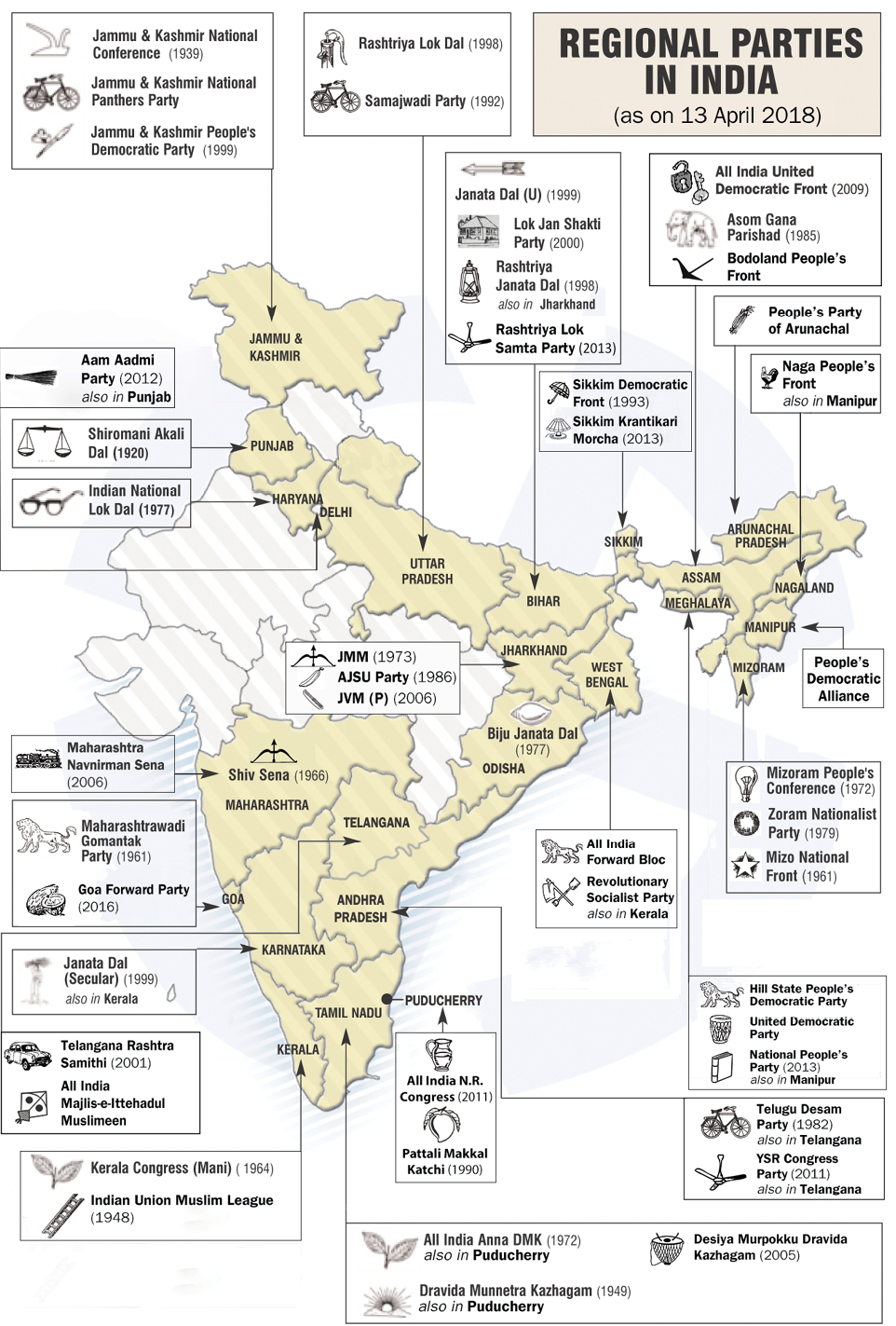
Challenges to political parties
We have seen how crucial political parties are for the working of democracy. Since parties are the most visible face of democracy, it is natural that people blame parties for whatever is wrong with the working of democracy. All over the world, people express strong dissatisfaction with the failure of political parties to perform their functions well. This is the case in our country too. Popular dissatisfaction and criticism has focussed on four problem areas in the working of political parties. Political parties need to face and overcome these challenges in order to remain effective instruments of democracy.
Berlusconi Puppet Theatre
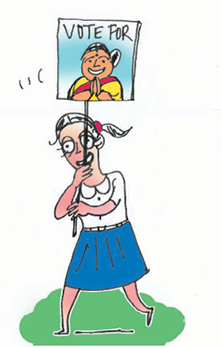
Why don’t parties give enough tickets to women? Is that also due to lack of internal democracy?
The first challenge is lack of internal democracy within parties. All over the world there is a tendency in political parties towards the concentration of power in one or few leaders at the top. Parties do not keep membership registers, do not hold organisational meetings, and do not conduct internal elections regularly. Ordinary members of the party do not get sufficient information on what happens inside the party. They do not have the means or the connections needed to influence the decisions. As a result the leaders assume greater power to make decisions in the name of the party. Since one or few leaders exercise paramount power in the party, those who disagree with the leadership find it difficult to continue in the party. More than loyalty to party principles and policies, personal loyalty to the leader becomes more important.
The second challenge of dynastic succession is related to the first one. Since most political parties do not practice open and transparent procedures for their functioning, there are very few ways for an ordinary worker to rise to the top in a party. Those who happen to be the leaders are in a position of unfair advantage to favour people close to them or even their family members. In many parties, the top positions are always controlled by members of one family. This is unfair to other members of that party. This is also bad for democracy, since people who do not have adequate experience or popular support come to occupy positions of power. This tendency is present in some measure all over the world, including in some of the older democracies.
The third challenge is about the growing role of money and muscle power in parties, especially during elections. Since parties are focussed only on winning elections, they tend to use short-cuts to win elections. They tend to nominate those candidates who have or can raise lots of money. Rich people and companies who give funds to the parties tend to have influence on the policies and decisions of the party. In some cases, parties support criminals who can win elections. Democrats all over the world are worried about the increasing role of rich people and big companies in democratic politics.
The fourth challenge is that very often parties do not seem to offer a meaningful choice to the voters. In order to offer meaningful choice, parties must be significantly different. In recent years there has been a decline in the ideological differences among parties in most parts of the world. For example, the difference between the Labour Party and the Conservative Party in Britain is very little. They agree on more fundamental aspects but differ only in details on how policies are to be framed and implemented. In our country too, the differences among all the major parties on the economic policies have reduced. Those who want really different policies have no option available to them. Sometimes people cannot even elect very different leaders either, because the same set of leaders keep shifting from one party to another.
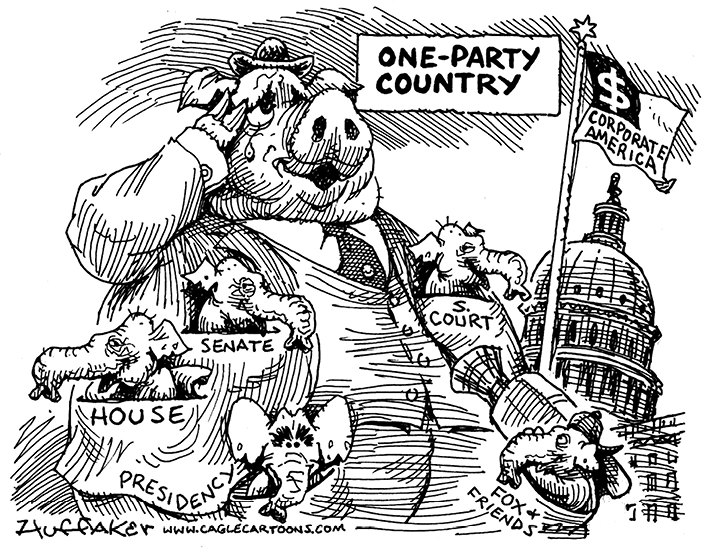
This cartoon was drawn during the Presidency of George Bush of the Republican Party in the USA. The party’s symbol is elephant. The cartoon seems to suggest that the Corporate America controls all major institutions of the country.
© Huffaker - Cagle Cartoons Inc., 16 June 2004

Can you identify which of the challenges described in this section are being highlighted in these cartoons (on pages 83 to 85)? What are the ways to curb the misuse of money and muscle power in politics?
© Manjul - DNA![18cart.tif]()

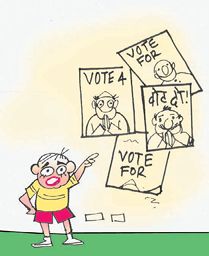
Does this suggest that in democracies people contest elections only to make money? But isn’t it true that there are politicians committed to the well-being of the people?
How can parties be reformed?
In order to face these challenges, political parties need to be reformed. The question is: Are political parties willing to reform? If they are willing, what has prevented them from reforming so far? If they are not willing, is it possible to force them to reform? Citizens all over the world face this question. This is not a simple question to answer. In a democracy, the final decision is made by leaders who represent political parties. People can replace them, but only by another set of party leaders. If all of them do not wish to reform, how can anyone force them to change?
Let us look at some of the recent efforts and suggestions in our country to reform political parties and its leaders:

Defection: Changing party allegiance from the party on which a person got elected (to a legislative body) to a different party.
The Constitution was amended to prevent elected MLAs and MPs from changing parties. This was done because many elected representatives were indulging in defection in order to become ministers or for cash rewards. Now the law says that if any MLA or MP changes parties, he or she will lose the seat in the legislature. This new law has helped bring defection down. At the same time this has made any dissent even more difficult. MPs and MLAs have to accept whatever the party leaders decide.
Affidavit: A signed document submitted to an officer, where a person makes a sworn statement regarding her personal information.
The Supreme Court passed an order to reduce the influence of money and criminals. Now, it is mandatory for every candidate who contests elections to file an affidavit giving details of his property and criminal cases pending against him. The new system has made a lot of information available to the public. But there is no system of check if the information given by the candidates is true. As yet we do not know if it has led to decline in the influence of the rich and the criminals.
The Election Commission passed an order making it necessary for political parties to hold their organisational elections and file their income tax returns. The parties have started doing so but sometimes it is mere formality. It is not clear if this step has led to greater internal democracy in political parties.
Besides these, many suggestions are often made to reform political parties:
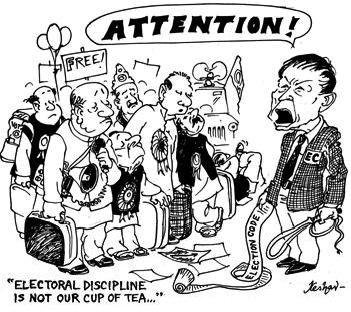
Do you agree that this form of reforming political parties will be acceptable to them?
A law should be made to regulate the internal affairs of political parties. It should be made compulsory for political parties to maintain a register of its members, to follow its own constitution, to have an independent authority, to act as a judge in case of party disputes, to hold open elections to the highest posts.
It should be made mandatory for political parties to give a minimum number of tickets, about one-third, to women candidates. Similarly, there should be a quota for women in the decision making bodies of the party.
There should be state funding of elections. The government should give parties money to support their election expenses. This support could be given in kind: petrol, paper, telephone etc. Or it could be given in cash on the basis of the votes secured by the party in the last election.
These suggestions have not yet been accepted by political parties. If and when these are accepted these could lead to some improvement. But we must be very careful about legal solutions to political problems. Over-regulation of political parties can be counter-productive. This would force all parties to find ways to cheat the law. Besides, political parties will not agree to pass a law that they do not like.
There are two other ways in which political parties can be reformed. One, people can put pressure on political parties. This can be done through petitions, publicity and agitations.
Ordinary citizens, pressure groups and movements and the media can play an important role in this. If political parties feel that they would lose public support by not taking up reforms, they would become more serious about reforms. Two, political parties can improve if those who want this join political parties.
The quality of democracy depends on the degree of public participation. It is difficult to reform politics if ordinary citizens do not take part in it and simply criticise it from the outside. The problem of bad politics can be solved by more and better politics. We shall return to this theme in the final chapter.
Exercise
1. State the various functions political parties perform in a democracy.
2. What are the various challenges faced by political parties?
3. Suggest some reforms to strengthen parties so that they perform their functions well?
4. What is a political party?
5. What are the characteristics of a political party?
6. A group of people who come together to contest elections and hold power in the government is called a _____________________.
7. Match List I (organisations and struggles) with List II and select the correct answer using the codes given below the lists:
| List I | List II | |
| 1 | Congress Party | A. National Democratic Alliance |
| 2 | Bharatiya Janata Party | B. State party |
| 3 | Communist Party of India (Marxist) | C. United Progressive Alliance |
| 4 | Telugu Desam Party | D. Left Front |
(a) C A B D


